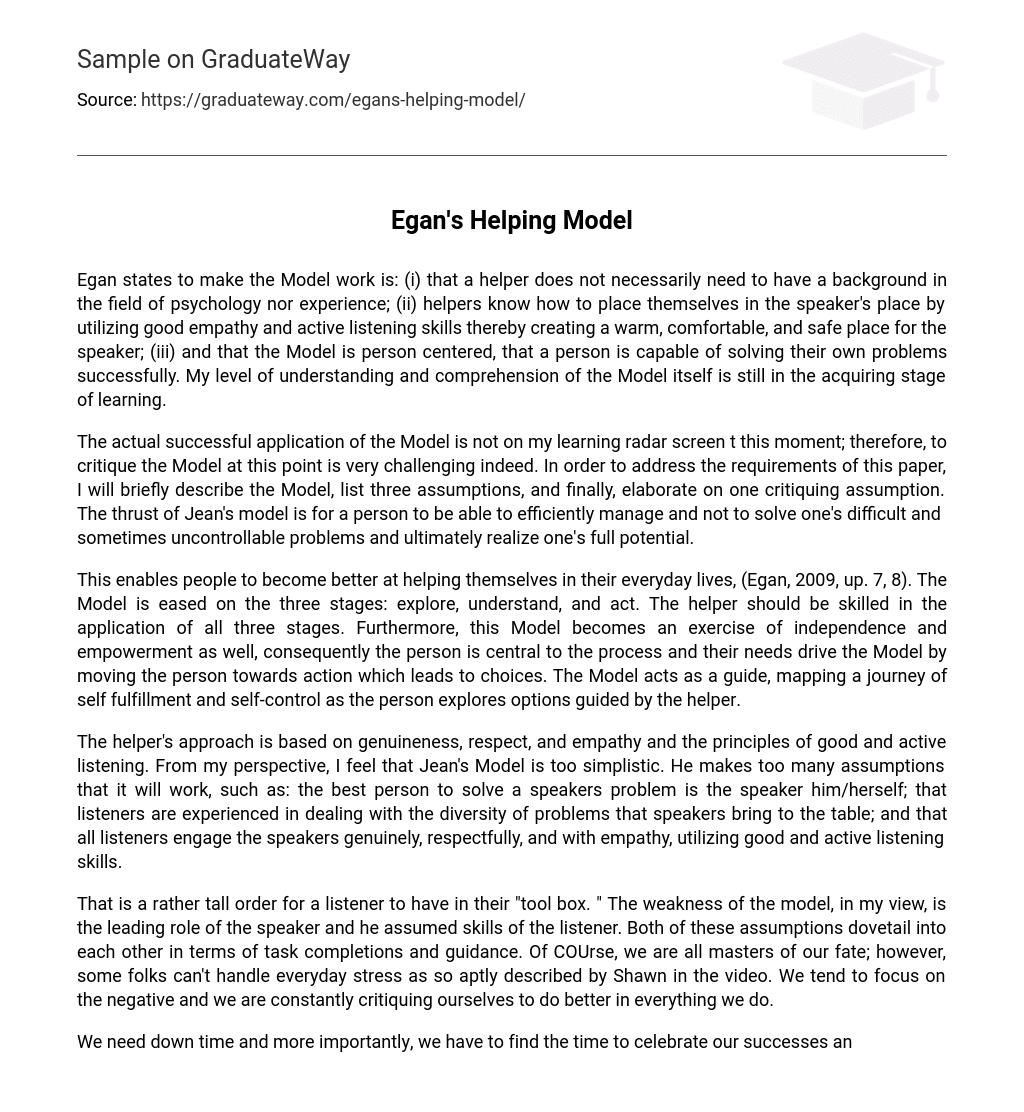According to Egan, the key elements for the successful implementation of the Model are: (i) the helper does not need to have a background in psychology or prior experience; (ii) helpers should have strong empathy and active listening skills to create a warm and safe environment for the speaker; (iii) the Model is person-centered, allowing individuals to solve their own problems effectively. Currently, my understanding of the Model is still in the learning and acquiring stage.
The current application of the Model is not currently within my scope of learning. As a result, critiquing the Model at this time poses a significant challenge. In order to meet the requirements of this paper, I will provide a brief description of the Model, list three assumptions, and finally, expand on one specific critiquing assumption. Jean’s model emphasizes the importance of effectively managing, rather than solving, difficult and often uncontrollable problems in order to ultimately achieve one’s maximum potential.
This Model (Egan, 2009, up. 7, 8) enables individuals to improve their ability to assist themselves in their daily lives. It is based on three stages: explore, understand, and act. The application of all three stages requires the helper to have the necessary skills. Additionally, this Model promotes independence and empowerment, with the individual being central to the process. Their needs are the driving force behind the Model, guiding them towards action and making choices. The Model serves as a guide that helps the person navigate a journey of self-fulfillment and self-control, with the support of the helper.
The helper’s method relies on genuineness, respect, and empathy, as well as the principles of good and active listening. However, I believe that Jean’s Model oversimplifies things. It assumes that the speaker is always the best person to solve their own problems, that listeners have experience dealing with the range of issues speakers present, and that all listeners engage genuinely, respectfully, and empathetically while utilizing good and active listening skills.
That is a rather tall order for a listener to have in their “tool box. ” The weakness of the model, in my view, is the leading role of the speaker and he assumed skills of the listener. Both of these assumptions dovetail into each other in terms of task completions and guidance. Of COUrse, we are all masters of our fate; however, some folks can’t handle everyday stress as so aptly described by Shawn in the video. We tend to focus on the negative and we are constantly critiquing ourselves to do better in everything we do.
We need time to relax and celebrate our achievements before taking on new challenges. However, it is important to analyze the role of the speaker (the person facing difficulties) in the Model. The speaker plays a central role and seeks help. However, speaking to someone like myself may cause additional problems. The Model divides the helping and problem-solving process into three stages.
The Model consists of various stages, each comprising three tasks that contribute to defining the stage and its associated process. While the theoretical application of the Model follows a sequential order, in practice, it is common for tasks to overlap, resulting in the helping process moving both forward and backward between stages. This can lead to complications, particularly if task one must be successfully completed before moving on to task three but is neglected in favor of directly proceeding to task three. Is there a lack of vertical alignment in this scenario? Has a critical aspect been disregarded?
The inexperience of the helper may raise concerns about their ability to properly assist. They might perceive the process as inflexible, leading to frustration and potentially a subpar outcome. Conversely, there may be a tendency to hastily progress through each stage instead of allowing the relationship between the speaker and helper to develop naturally. Ultimately, a trained counselor is best suited to address the speaker’s concerns and devise a plan based on their input.
Additionally, new issues can arise from unskilled helpers, and these helpers may provide inadequate guidance during problem-solving. In summary, I believe that Jean’s Model can be somewhat effective but with less assistance. Moreover, he incorrectly suggests that unskilled individuals can lead a person to empowerment in their daily lives, which is a commendable goal. However, the journey from being controlled by problems to self-control and empowerment is a gradual process that requires proper guidance and time.





